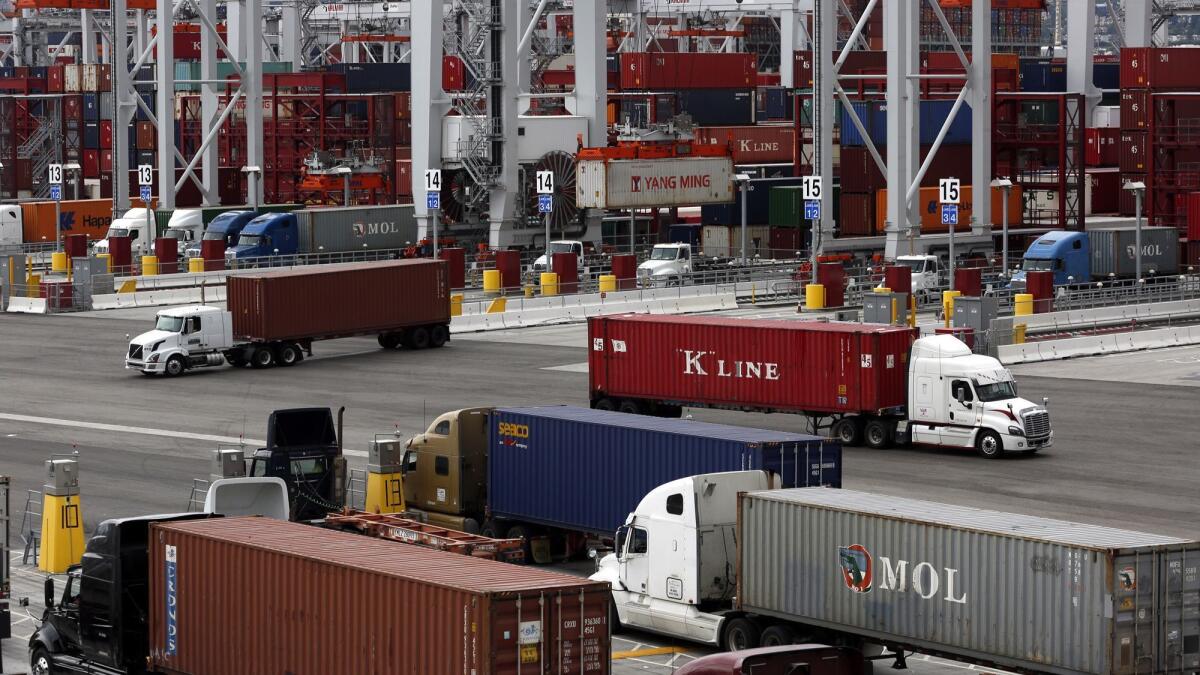Editorial: The rise of robots doesn’t have to mean the fall of human workers

- Share via
Hundreds, maybe thousands, of dockworkers, residents and business owners are expected to pack the Board of Harbor Commissioners hearing Tuesday morning in an attempt to block a permit for infrastructure improvements at one Port of Los Angeles terminal that they fear would pave the way for the loss of high-paying jobs and the economic decline of surrounding communities.
This small project — about $1.5 million worth of electric charging stations, poles for Wi-Fi antenna and the like — would be a precursor to a big change in San Pedro and harbor communities. APM Terminals and Danish shipping giant Maersk intend to automate operations over the next several years, potentially slashing the number of dockworkers in the future. These are middle-class jobs that can often pay workers without a college degree more than $100,000 a year.
But, really, this fight goes far beyond APM Terminals. Two other terminals in the massive Los Angeles-Long Beach port complex have already automated. And all along the supply chain of factories, docks, highways and warehouses, many blue-collar workers could see their jobs changed — or eliminated — by a new robot workforce that will be able to pack boxes, move containers and drive trucks. And the situation at the ports is a microcosm of what’s happening with automation in workplaces around the world.
Enter the Fray: First takes on the news of the minute »
The International Longshore and Warehouse Union had, in fact, agreed in 2008 and 2015 to allow West Coast ports to automate in exchange for pension increases and job security for current dockworkers. Having won the benefits, the union is now leading a campaign (with the support of numerous Democratic office holders) to stop or at least slow automation in the name of community protection.
The Harbor Commission should approve the permit, but if it does, Los Angeles Councilman Joe Buscaino, who represents San Pedro, is expected to press the City Council to reverse the decision. APM Terminals will probably sue, and the fight will continue in court for who knows how long.
In the meantime, the march toward automation will continue, as it should. History shows that technological innovation, from the combine harvester to the computer, can make work safer, more productive and ultimately strengthen the economy. Yet innovation can also produce losers — namely, the often low-skilled workers displaced by technology and the communities that rely on those workers. U.S. industries and the government have a mixed record on supporting and retraining workers affected by technological advancement and global trade.
The question is how we automate without leaving workers behind. Figuring that out will require employers, labor and public officials to work together to train and retrain workers for the jobs of the future. Unions have a responsibility to defend the interests of more than just their current members, just as industry has a responsibility to help the next generation of workers prepare for a new type of work. And government has to get communities ready for the changes to come, while also doing a better job of ensuring that the benefits of increased efficiency and productivity aren’t captured just by the employers hiring fewer workers.
Follow the Opinion section on Twitter @latimesopinion and Facebook
More to Read
A cure for the common opinion
Get thought-provoking perspectives with our weekly newsletter.
You may occasionally receive promotional content from the Los Angeles Times.









